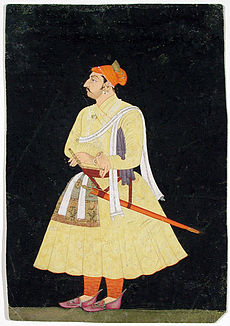Rathore dynasty
Appearance

The Rathore is a clan of Hindu Rajputs found in Northern India.[1] They form a part of the thirty-six Rajput Clans.[2] Alternative spellings include Rathaur or Rathor or Rathur or Rathod or Rathour or Rahtore. The bravery of the Rathore horsemen was appreciated by Benoît de Boigne after his campaign against them.[3]
The Rathores variously claim descent from the Suryavansha (solar dynasty)[4]
Rathore states
The various cadet branches of the Rathore clan gradually spread to encompass all of Marwar and later founded states in Central India and Gujarat. The Marwar Royal family is considered the head house of Rathores. At the time of India's independence in 1947, the princely states ruled by various branches of the Rathore clan included:[5][6]
- Jodhpur (Marwar) in present-day Rajasthan, founded in 1459 by Rao Jodha Ji.
- Bikaner in present-day Rajasthan, founded in 1465 by Rao Bikaji (son of Rao Jodha).
- Kishangarh in present-day Rajasthan, founded in 1611 by Raja Kishan Singh.
- Idar in present-day Gujarat, founded in 1729 by Rao Anand Singh.
- Ratlam in present-day Madhya Pradesh, founded in 1651 by Maharaja Ratan Singh.
- Jhabua in present-day Madhya Pradesh, founded in 1584 by Raja Keshav Das.
- Sitamau in present-day Madhya Pradesh, founded 1701 by Raja Kesho Das.
- Sailana in present-day Madhya Pradesh, founded in 1730 by Raja Jai Singh.
- Alirajpur in present-day Madhya Pradesh, founded in 1437 by Raja Anand Deo.
Notable people
See
References
- ^ A. M. Shah (1998). The Family in India: Critical Essays. Orient Blackswan. pp. 112–. ISBN 978-81-250-1306-8.
- ^ A History of Rajasthan, Section:The Rathores of Marwar [1], pg.372, by Rima Hooja, ISBN 9788129108906 — "The Rathores are amongst the traditionally listed thirty-six Rajput clans."
- ^ Fall of the Mughal Empire: 1789–1803, Jadunath Sarkar, p 29 — "It is but just to the enemy to acknowledge that, considering the situation in which they were found, and the disorder consequent thereto, they behaved very valiantly"
- ^ Indian India. Director of Public Relations, Chamber of Princes. 1 January 1945.
- ^ Indian Princely Medals: A Record of the Orders, Decorations, and Medals by Tony McClenaghan, pg 179
- ^ Dhananajaya Singh (1994). The House of Marwar. Lotus Collection, Roli Books. p. 13.
He was the head of the Rathore clan of Rajputs, a clan which besides Jodhpur had ruled over Bikaner, Kishengarh, Idar, Jhabhua, Sitamau, Sailana, Alirajpur and Ratlam, all States important enough to merit gun salutes in the British system of protocol. These nine Rathore States collectively brought to India territory not less than 60,000 square miles in area.
Further reading
- Jadunath Sarkar (1960). Military History of India. Orient Longmans.
- Bose, Melia Belli (27 August 2015). Royal Umbrellas of Stone: Memory, Politics, and Public Identity in Rajput Funerary Art. p. 140. ISBN 9789004300569.
- Niyogi, Roma (1959). The History of the Gāhaḍavāla Dynasty. Oriental. OCLC 5386449.
